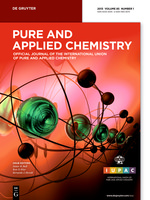 A new issue of Pure and Applied Chemistry is now available on De Gruyter Online.
A new issue of Pure and Applied Chemistry is now available on De Gruyter Online.
Please click on the following links to view the articles:
Pure and Applied Chemistry Volume 95, Issue 6
Frontmatter
Sept 8, 2023 Page range: i-iii
Editorial
Special issue in honour of Dr. Mary Lowe Good
Lidia Armelao, Lars Öhrström, Daniel Rabinovich, Miki Hasegawa
https://doi.org/10.1515/pac-2023-2006
PAC keyword: Mary L. Good
Special Topic Papers
Shinya Kimura and Masamichi Yamanaka
Metal ion-assisted supramolecular gelation 633
Zhi Liang Dong, Zhiqiang Wang, Yun-Mui Yiu, Jiamin Fu, Bi-Hsuan Lin, Lo-Yueh Chang and Tsun-Kong Sham
Synthesis and optical properties of phosphorus doped ZnO: X-ray absorption, X-ray emission, and X-ray excited optical luminescence studies 643
Ibtihel Zaier, Zafer Eroglu and Önder Metin
A facile preparation of graphene hydrogel-supported bimetallic RuM (M: Co, Ni, Cu) nanoparticles as catalysts in the hydrogen generation from ammonia borane 655
Silvia Carlotto, Luca Babetto, Marzio Rancan, Gregorio Bottaro, Maurizio Casarin and Lidia Armelao
How to get deeper insights into the optical properties of lanthanide systems: a computational protocol from ligand to complexes 671
Pavel Karen
Heuristic algorithms for understanding chemistry via simple quantities 683
Shintaro Akagi, Junhao Wang, Kenta Imoto, Kunal Kumar, Shin-ichi Ohkoshi and Hiroko Tokoro
A NiII–WV(CN)8 layer magnet showing metamagnetic behavior 701
Yuna Kim and Kazuya Kubo
Transition metal complexes for electrochromic and electrofluorochromic devices 707
Keiichiro Ozawa, Hideyuki Tanaka, Hitomi Ohmagari, Megumi Ishii, Shinya Kimura, Kenta Goto, Shogo Kawaguchi, Masamichi Yamanaka and Miki Hasegawa
Dispersion control by using a bulky surfactant medium in the LB films for the enhancement of linearly polarized luminescence of Eu complexes 733
—

Mary L. Good [1–3] was born in Grapewine (Texas, USA) and was drawn to chemistry after learning about Marie Curie and her captivating scientific achievements. She graduated in chemistry from the University of Central Arkansas and received her PhD in inorganic chemistry from the University of Arkansas, Fayetteville in 1955. She started her academic career at the chemistry faculty of Louisiana State University in Baton Rouge and she moved to the New Orleans campus of the Louisiana State University in 1958. In 1980 she became vice president and director of research for Universal Oil Products and worked on innovative technologies, such as the development of processes to remedy hazardous waste streams. Along the way she pursued other activities, including one year as president of the American Chemical Society.
Dr. Mary Good, as a professor at Louisiana State University, pioneered the experimental technique of Mössbauer spectroscopy, which uses gamma rays, in 1967. She applied this technique to clarify the molecular structure of complicated systems including metal ions, especially for the characterization of ruthenium catalysts [4–6]. The study on stabilization of ruthenium compounds is known as the base of future investigations of automotive emission control catalysts [7, 8].
In addition to a distinguished career in academia, industry and government, Mary L. Good was the first woman to be elected as head of an IUPAC technical division, serving as President of Division II (Inorganic Chemistry) from 1981 to 1985, and as member of the Bureau and the Executive Committee of IUPAC for eight years (1985–1993) [9].

The special issue of PAC dedicated to Mary L. Good includes contributions from different areas of inorganic chemistry, covering solid state magnetochemistry, equilibria in solution, hybrid gel – inorganic chemistry, thin solid 2D films, ‘lanthanide’ chemistry, nanomaterials, and physics in inorganic materials.
Refs
[1] M. A. Cavanaugh. Science 368, 371 (2020), https://doi.org/10.1126/science.abb9780.Search in Google ScholarPubMed
[2] Mary L. Good Scientific Biography, Science History Institute, including an oral history interview conducted 2 June 1998. https://www.sciencehistory.org/education/scientific-biographies/mary-lowe-good/.
[3] L. Wang. Obituaries in Chem. Eng. News (2019), https://cen.acs.org/people/obituaries/Mary-L-dies-age-88/97/web/2019/11.
[4] M. L. Good, M. D. Patil, J. T. Donner, C. P. Madhusudahan. Adv. Chem. 194, 553 (1981).10.1021/ba-1981-0194.ch026
[5] D. J. Miller, S. C. Srivastava, M. L. Good. Anal. Chem. 37, 739 (1965), https://doi.org/10.1021/ac60225a028
[6] M.L. Good, M. Akbarnejad, J. Donner. Erdol & Kohle Erdgas Petrochemie 34, 264 (1981).
[7] C. A. ClausenIII, M. L. Good. J. Catal. 46, 58 (1977), https://doi.org/10.1016/0021-9517(77)90135-x.
[8] M. L. Good, M. Akbarnejad, J. Donner. Mater. Res. Soc. Symp. Proc. 3, 271 (1981).10.1557/PROC-3-271
[9] N. Moreau, Chem. Int. 41(3), 53 (2019), https://doi.org/10.1515/ci-2019-0317.
